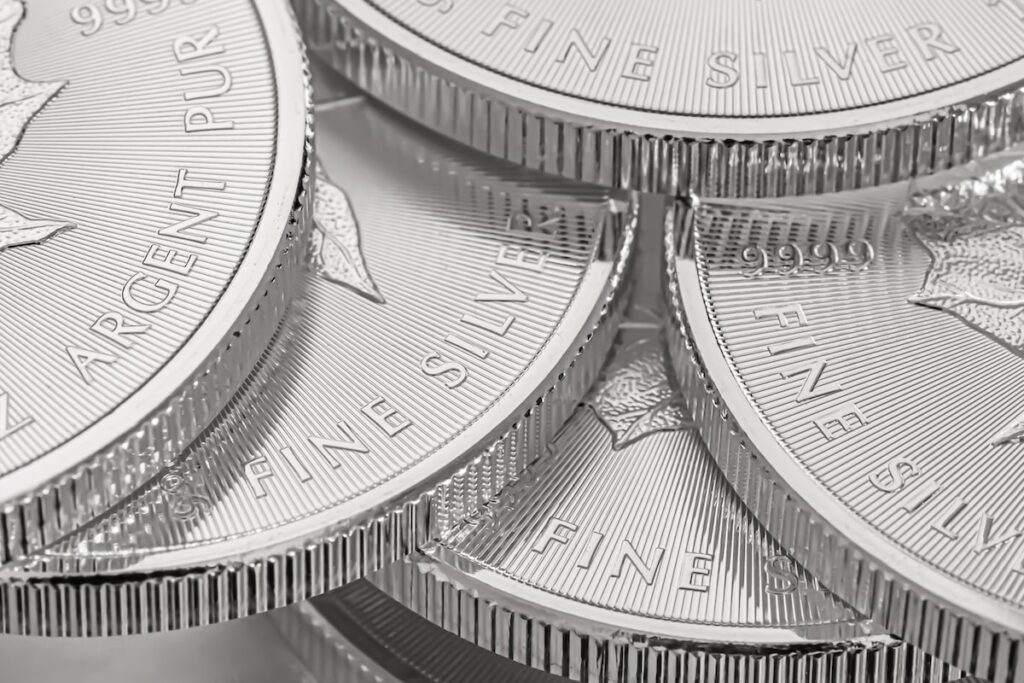Silver is a unique and valuable metal that is prized for its value, collectibility, density, and sheer weight.
Silver is a fairly dense metal, and is therefore fairly heavy.
A silver coin typically weighs 28 g (1 oz). A typical silver bar can weigh 1 oz (28 g), 5 oz (142 g), 10 oz (283 g). Larger silver bars can weigh 100 Troy Ounces (3.11 kg). And a cubic centimeter of silver weighs 10.49 g (0.37 oz).
Some novice collectors might find it surprising that an ounce of silver is 75 times gold based on the Gold to Silver Ratio (GSR), as demonstrated by the YouTuber Yankee Stacking when he visited the SD Bullion facilities in January 2023:

30,000 otz (troy ounces) of silver is equal to 400 otz of gold in USD value.
That is a very impressive stat to know for stackers, especially if you want to have a lighter load by stacking gold instead of silver. I personally stack both for different reasons.
A piece of silver will be heavier than a piece of iron or copper of the same size but lighter than a similar-sized piece of gold or lead.
Read on to learn more about silver and its density when compared to other common metals, as well as how to calculate the weight of silver and weigh it correctly.
How Much Does Silver Weigh per Volume?
Every material has two essential properties we can use to calculate its weight: volume and density.
For the uninitiated, volume can be thought of as the amount of physical space something takes up, while density refers to how compact the substance is.
A classic illustration of this is comparing a kilogram of iron to a kilogram of feathers.
Feathers will take up more space as they have much less density.
| Volume | Silver Weight |
| Cubic Centimeter | 10.49 g (0.37 oz) |
| Cubic Foot | 297 kg (655 lb) |
| Cubic Inch | 172 g (6 oz) |
Above is a table containing various measurements of silver by volume and their weights, which we can use to calculate the weight of silver by its volume and vice versa.
A pound of silver (0.45 kg) is 2.64 cubic inches (43.2 cubic cm).
How Heavy Is Silver Compared To Other Metals?
While silver is denser than some metals, it’s less dense than others.
This can be demonstrated by a comparison of the weight-to-volume ratio of different metals.
Here is a table comparing the weights of different metals to silver based on 1 cubic inch (or 16.3 cubic centemeters):
| Metal | Weight |
| Gold | 316 g (0.7 lbs) |
| Lead | 185 g (0.4 lbs) |
| Pure Silver | 172 g (0.38 lbs) |
| Sterling Silver | 169 g (0.37 lbs) |
| Copper | 146 g (0.32 lbs) |
| Nickel | 146 g (0.32 lbs) |
| Steel | 131 g (0.29 lbs) |
| Aluminum | 46 g (0.1 lbs) |
Gold is the most dense metal on our list, also giving it the most value for weight when stacking.
Pure silver is lighter than gold and lead, but heavier than nickel, steel, copper, aluminum, and sterling silver, as shown in the table below.
How Much Does Confederate Silver Weigh?
Confederate silver is both highly valuable and highly collectible. That said, there weren’t that many coins minted in the Confederate States of America.
While the nation had planned to mint its own currency, only four half-dollar silver coins were struck during the Confederacy’s existence.
Later, there was a restrike of 500 Confederate half-dollars.
Each of the four Confederate half-dollar silver coins weighs 12.44 g (0.43 oz), which is approximately the same as the Union coins.
All four of the coins are accounted for, so any others found in circulation are either counterfeit or replicas.
Any other silver currency used in the Confederacy was struck using the same dies used to mint Union silver.
The restrike, carried out by one J.W. Scott of New York, made use of New Orleans-minted Union dollars that carried the Lady Liberty on one side and had the other side shaved flat and restruck with the original die.
These would presumably weigh less than the originals due to the shaving of one side.
What Metal Weighs the Same as Silver?
Silver is fairly dense as far as metals go.
It is heavier than most common metals like copper and iron, which makes it a little more challenging for counterfeiters to reproduce.
No metal weighs the same as silver when considering the same volume.
The closest metals in weight per volume are lead, molybdenum, palladium, and bismuth, but none weigh exactly the same. They are all heavier or lighter to a degree.
How Do You Calculate the Weight of Silver?
To calculate the weight of silver, you’d need to consider the volume of the silver you want to know the weight of, as well as the mass.
To calculate the weight of silver, multiply the volume of a piece of silver by the density of silver, which is 10.49 g (0.37 oz) per cubic centimeter.
Ideally, you’ll want to use metric units – you can divide cubic inches by 16.3871 to convert to cubic centimeters and multiply your answer by 10.49.
This calculation is useful for verifying the authenticity of silver. If the weight of a silver piece does not match this calculation, it is likely a counterfeit.
How Heavy Is a Silver Bar?
Silver bars come in a variety of shapes and sizes. They are typically denominated by their weight rather than having a standard volume.
A typical silver bar weighs 100 Troy Ounces (3.11 kg). The bars also come in denominations of 1 kilogram (2.2-lbs), but the most popular bars are of smaller sizes, typically 1 oz (28 g), 5 oz (142 g), 10 oz (283 g), and 100 oz (2.8 kg).
Silver bars are normally marked with their weight.
While silver is heavier than most common metals, it is possible to create a convincing counterfeit by carefully alloying metals like lead and copper and then plating them with silver.
As such, you should always be wary when purchasing bullion privately.
How Is Silver Weighed?
If you use your kitchen scale to weigh a silver bar, you might find yourself confused when the weight stamped on the bar differs from the scale reading.
Silver is weighed using a unit of measurement called a Troy Ounce, which is slightly different from a regular ounce. A Troy Ounce (abbreviated as t oz) is equal to 1.097 standard ounces or 31.1035 grams.
Many countries use gram measurements instead of Troy Ounces; for example, the Chinese gold and silver Panda bullion coins were revised in 2016 to use grams instead (source).
Throughout history, silver has been prized for its beauty and value but not quite as much as its considerably heavier sister metal, gold.
It’s still heavier than a number of other common metals, and it is important for any aspiring silver stacker to be aware of the differences in weight.




